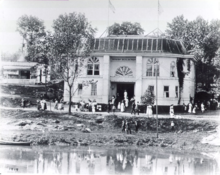
The Knoxville Gazette was the first newspaper published in the U.S. state of Tennessee and the third published west of the Appalachian Mountains. Established by George Roulstone (1767–1804) at the urging of Southwest Territory governor William Blount, the paper's first edition appeared on November 5, 1791. The Gazette provided an important medium through which Tennessee's frontier government could dispense legislative announcements, and the paper's surviving editions are now an invaluable source of information on life in early Knoxville.
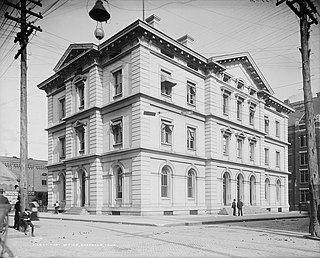
The Old Customs House, also called the Old Post Office, is a historic building located at the corner of Clinch Avenue and Market Street in Knoxville, Tennessee, United States. Completed in 1874, it was the city's first federal building. It housed the federal courts, excise offices and post office until 1933. From 1936 to 1976, it was used by the Tennessee Valley Authority for offices. Expanded in 2004, the building is home to the East Tennessee History Center, which includes the Lawson McGhee Library's Calvin M. McClung Historical Collection, the Knox County Archives, and the East Tennessee Historical Society's headquarters and museum. The building is listed on the National Register of Historic Places for its architectural significance.
The East Tennessee Historical Society (ETHS), headquartered in Knoxville, Tennessee, United States, is a non-profit organization dedicated to the study of East Tennessee history, the preservation of historically significant artifacts, and educating the citizens of Tennessee. The society operates a museum and museum shop in the East Tennessee History Center on Gay Street in downtown Knoxville. The East Tennessee Historical Society was established in 1834, 38 years after the establishment of the state of Tennessee, to record the history of the development and settlement of the area.
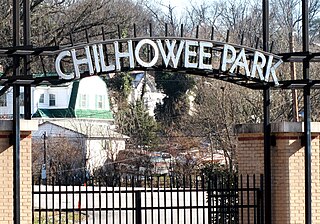
Chilhowee Park is a public park, fairgrounds and exhibition venue in Knoxville, Tennessee, United States, located off Magnolia Avenue in East Knoxville. Developed in the late 19th century, the park is home to the Tennessee Valley Fair and hosts several dozen expositions annually. The park covers 81 acres (33 ha), and includes a 57,100-square-foot (5,300 m2) exposition center, a 1910-era bandstand, a 4,500-seat amphitheater, and a 3-acre (1.2 ha) lake, Lake Ottosee. The park is also home to The Muse Knoxville, a children's science museum formerly known as the East Tennessee Discovery Center.

Chilhowee was a prehistoric and historic Native American site in present-day Blount and Monroe counties in Tennessee, in what were the Southeastern Woodlands. Although now submerged by the Chilhowee Lake impoundment of the Little Tennessee River, the Chilhowee site was home to a substantial 18th-century Overhill Cherokee town. It may have been the site of the older Creek village "Chalahume" visited by Spanish explorer Juan Pardo in 1567. The Cherokee later pushed the Muscogee Creek out of this area.

The National Conservation Exposition was an exposition held in Knoxville, Tennessee, United States, between September 1, 1913, and November 1, 1913. The exposition celebrated the cause of bringing national attention to conservation activities, especially in the Southeastern United States. The fair was held in what is now Knoxville's Chilhowee Park in East Knoxville.
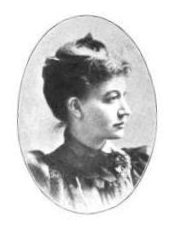
Margaret Elizabeth Crozier French was an American educator, women's suffragist and social reform activist. She was one of the primary leaders in the push for women's rights in Tennessee in the early 1900s, and helped the state become the 36th state to certify the 19th Amendment to the United States Constitution, giving women the right to vote, in 1920. She also founded the Ossoli Circle, the oldest federated women's club in the South, and led efforts to bring coeducation to the University of Tennessee.
East Knoxville is the section of Knoxville, Tennessee, USA, that lies east of the city's downtown area. It is concentrated along Magnolia Avenue (US-70/US-11), Martin Luther King, Jr., Boulevard, Dandridge Avenue, and adjacent streets, and includes the neighborhoods of Holston Hills, Parkridge, Chilhowee Park, Morningside, Five Points, and Burlington. East Knoxville is home to Zoo Knoxville, the Knoxville Botanical Garden and Arboretum, and Chilhowee Park.

Enoch Lloyd Branson (1853–1925) was an American artist best known for his portraits of Southern politicians and depictions of early East Tennessee history. One of the most influential figures in Knoxville's early art circles, Branson received training at the National Academy of Design in the 1870s and subsequently toured the great art centers of Europe. After returning to Knoxville, he operated a portrait shop with photographer Frank McCrary. He was a mentor to fellow Knoxville artist Catherine Wiley, and is credited with discovering twentieth-century modernist Beauford Delaney.

Anna Catherine Wiley was an American artist active primarily in the early twentieth century. After training with the Art Students League of New York and receiving instruction from artists such as Lloyd Branson and Frank DuMond, Wiley painted a series of impressionist works that won numerous awards at expositions across the Southern United States, and have since been displayed in museums such as the Metropolitan Museum of Art and the Morris Museum of Art. In 1926, Wiley was institutionalized after suffering a mental breakdown, and never painted again.

Johann Peter Staub colloquially Peter Staub was a Swiss-born American businessman, politician, and diplomat. Staub held several public offices, most notably as U.S. Consul to St. Gallen, appointed in 1885 by Grover Cleveland. Previously he served two terms as Mayor of Knoxville, Tennessee and as Consul of Switzerland in Tennessee from 1869 to 1884, promoting Swiss emigration to the Appalachian region. He was also an important colonizer who helped to established the town of Gruetli-Laager in 1869.

James Gilbert Sterchi was an American businessman, best known as the cofounder and head of the furniture wholesaler, Sterchi Brothers Furniture Company. At its height, Sterchi Brothers was the world's largest furniture store chain, with sixty-five stores across the southeastern United States and a worldwide customer base. In 1946, the company became the first Knoxville-based firm to be listed on the New York Stock Exchange. The company's ten-story headquarters, now called Sterchi Lofts, stands prominently along Knoxville's skyline, and Sterchi's home in northern Knoxville, Stratford Mansion, is listed on the National Register of Historic Places.

Chilhowee Park is a residential neighborhood in Knoxville, Tennessee, United States, located off Magnolia Avenue in the East Knoxville area. Developed as a streetcar suburb in the 1890s, this neighborhood was initially part of Park City, which was incorporated as a separate city in 1907, and annexed by Knoxville in 1917. Chilhowee Park lies adjacent to one of Knoxville's largest municipal parks, as well as Zoo Knoxville. The neighborhood contains a notable number of early-20th-century houses.
Joseph Knaffl was an American art and portrait photographer, active in Knoxville, Tennessee, during the late 19th and early 20th centuries. He is best known for his 1899 portrait, "Knaffl Madonna," which has been reprinted thousands of times, and is still used for Hallmark Christmas cards. Knaffl was a partner in two Knoxville studios: Knaffl and Brother, formed in 1884, and Knaffl and Brakebill, formed in 1909.
Charles Ives Barber was an American architect, active primarily in Knoxville, Tennessee, and vicinity, during the first half of the 20th century. He was cofounder of the firm, Barber & McMurry, through which he designed or codesigned buildings such as the Church Street Methodist Episcopal Church, South, the General Building, and the Knoxville YMCA, as well as several campus buildings for the University of Tennessee and numerous elaborate houses in West Knoxville. Several buildings designed by Barber have been listed on the National Register of Historic Places.
Richard Franklin Graf (1863–1940) was an American architect active primarily in Knoxville, Tennessee and the vicinity in the early 20th century. His works include Stratford Mansion (1910), Sterchi Building (1921), St. John's Lutheran Church (1913), and the Journal Arcade (1924). His home, the Prairie School-inspired Graf House, is considered Knoxville's first modern home. Several buildings designed by Graf have been listed on the National Register of Historic Places.

The History of Knoxville, Tennessee, began with the establishment of James White's Fort on the Trans-Appalachian frontier in 1786. The fort was chosen as the capital of the Southwest Territory in 1790, and the city, named for Secretary of War Henry Knox, was platted the following year. Knoxville became the first capital of the State of Tennessee in 1796, and grew steadily during the early 19th century as a way station for westward-bound migrants and as a commercial center for nearby mountain communities. The arrival of the railroad in the 1850s led to a boom in the city's population and commercial activity.

Mary Boyce Temple was an American philanthropist and socialite, active primarily in Knoxville, Tennessee, in the late 19th and early 20th centuries. She was the first president of the Ossoli Circle, the oldest federated women's club in the South, and published a biography of the club's namesake, Margaret Fuller Ossoli, in 1886. She also cofounded the Tennessee Woman's Press and Author's Club, the Knoxville Writer's Club, and the Knox County chapter of the League of Women Voters. She represented Tennessee at various international events, including the Paris Exposition of 1900 and at the dedication of the Panama Canal in 1903.
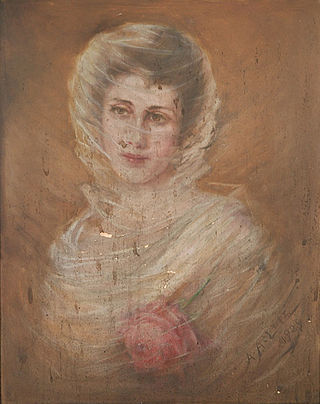
Adelia Armstrong Lutz was an American artist active in the late nineteenth and early twentieth centuries. She organized art circles in Knoxville, Tennessee, as director of the Knoxville Art Club and as a co-organizer of the Nicholson Art League. Her still lifes and portraits were exhibited throughout the American South, and they are to be the subject of a permanent exhibit at her former home, Historic Westwood.
The following is a timeline of the history of the city of Knoxville, Knox County, Tennessee, USA.

